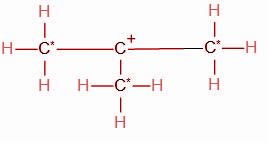
How many $\alpha $ hydrogen does this carbocation have?


Answer
465.3k+ views
Hint: In an organic molecule, the carbon atom that is directly bonded to the functional group such as a carbonyl or hydroxyl group is known as the alpha carbon. The hydrogen atom attached to the alpha carbon atom is known as alpha hydrogen. In this case, the functional group is a carbocation.
Complete step by step answer:
We know that the carbon atom adjacent to the functional group is the alpha carbon atom. The functional group in the given compound is a carbocation, i.e. the carbon atom carrying the positive charge. This carbon atom is bonded to three other carbon atoms. Hence we can conclude that all three of these carbon atoms (Marked with a star) are alpha carbons.

Thus, the total number of alpha hydrogens in the carbocation are 9.
Additional information:
Due to close proximity to the functional group, alpha carbons are highly reactive and are responsible for almost all reactions of an organic compound. For example, in an aldehyde or ketone, the alpha hydrogens are acidic and undergo many reactions. It is acidic due to the strong electron withdrawing effect of the carbonyl group. Aldol condensation and Cannizzaro reaction are among the key reactions showing the reactivity of alpha hydrogens.
Note:
Alpha hydrogens play an important role in the stability of a carbocation. The more the number of alpha hydrogen atoms, more is the stability of the carbocation. This due to hyper conjugation of the alpha hydrogen. The electron bond pair of the alpha carbon hydrogen bond is transferred temporarily to the carbocation, thus, stabilizing it. More the number of alpha hydrogens, more is hyper conjugation and thus more is the stability of the carbocation due to delocalization of charge.
Complete step by step answer:
We know that the carbon atom adjacent to the functional group is the alpha carbon atom. The functional group in the given compound is a carbocation, i.e. the carbon atom carrying the positive charge. This carbon atom is bonded to three other carbon atoms. Hence we can conclude that all three of these carbon atoms (Marked with a star) are alpha carbons.

Thus, the total number of alpha hydrogens in the carbocation are 9.
Additional information:
Due to close proximity to the functional group, alpha carbons are highly reactive and are responsible for almost all reactions of an organic compound. For example, in an aldehyde or ketone, the alpha hydrogens are acidic and undergo many reactions. It is acidic due to the strong electron withdrawing effect of the carbonyl group. Aldol condensation and Cannizzaro reaction are among the key reactions showing the reactivity of alpha hydrogens.
Note:
Alpha hydrogens play an important role in the stability of a carbocation. The more the number of alpha hydrogen atoms, more is the stability of the carbocation. This due to hyper conjugation of the alpha hydrogen. The electron bond pair of the alpha carbon hydrogen bond is transferred temporarily to the carbocation, thus, stabilizing it. More the number of alpha hydrogens, more is hyper conjugation and thus more is the stability of the carbocation due to delocalization of charge.
Recently Updated Pages
The correct geometry and hybridization for XeF4 are class 11 chemistry CBSE

Water softening by Clarks process uses ACalcium bicarbonate class 11 chemistry CBSE

With reference to graphite and diamond which of the class 11 chemistry CBSE

A certain household has consumed 250 units of energy class 11 physics CBSE

The lightest metal known is A beryllium B lithium C class 11 chemistry CBSE

What is the formula mass of the iodine molecule class 11 chemistry CBSE

Trending doubts
Why was the Vernacular Press Act passed by British class 11 social science CBSE

Arrange Water ethanol and phenol in increasing order class 11 chemistry CBSE

Name the nuclear plant located in Uttar Pradesh class 11 social science CBSE

What steps did the French revolutionaries take to create class 11 social science CBSE

How did silk routes link the world Explain with three class 11 social science CBSE

What are the various challenges faced by political class 11 social science CBSE




